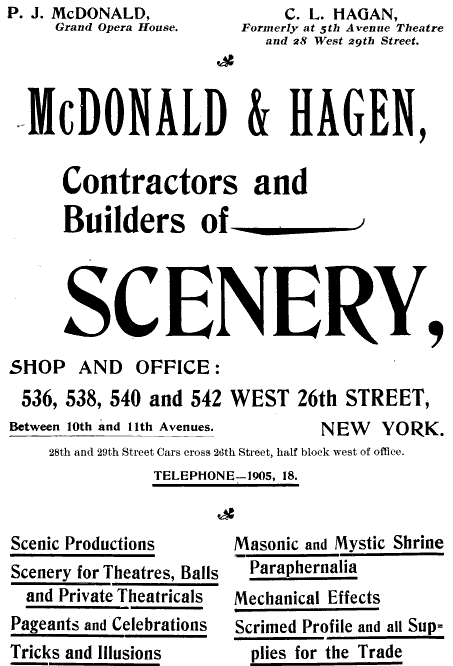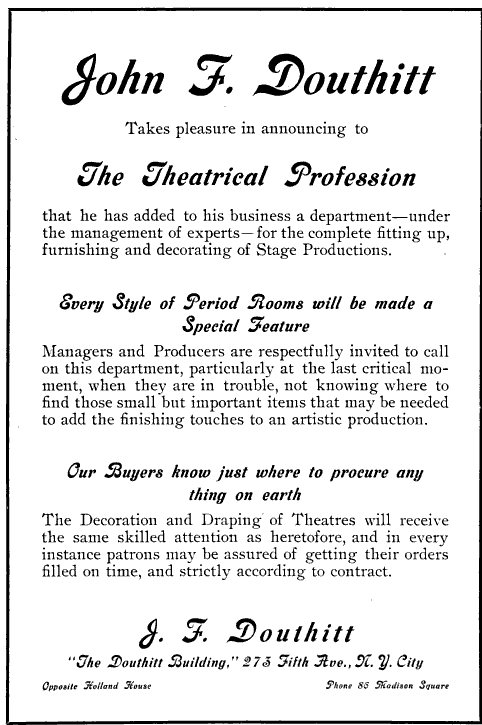I recently came across the Brick in the Yard Mold Supply YouTube Channel, which has well over a hundred videos on molding, casting and finishing techniques. I started off by watching this one on casting a rubber hammer. Brick in the Yard has been selling molding, casting and special effects supplies out of their shop in Texas since the mid-nineties, and their collection of videos give an in-depth look on how to use a lot of them. So check it out:
Tag Archives: supplies
Shams in the Theatre, 1880
The following article comes from The Daily Dispatch, Richmond, VA, December 2, 1880. I added a few paragraph breaks to make it a little easier on the eyes.
Shams in the Theatre
The Ingenious Work of the Property Man–Remarkable Effects Produced with Cheap and Common Materials.
(New York Tribune.)
Theatrical properties, so called, include all things placed upon the stage except what are painted as part of a scene by the scene-painter. Urns, vases, flowers, pictures, pianos, carpets, rugs, furniture, and all ornaments are “properties.” Besides these, all articles used by the actors in the performance of the play, such as canes, cigars, pistols, clubs, knives, pocketbooks, money, and other things of similar nature are properties. The property-man of a theatre has a responsible and arduous-position. Upon him depend many of the important points in a play. The check for $30,000 that saves the impecunious artist from an untimely grave; the secret drawer and hidden will, which, when revealed, restore the wandering heir to his rightful inheritance; the marriage-bell that hangs above the heads of the happy lovers in the fifth act; and the pitiless snow through which the shivering blind girl wanders singing her mournful songs, all are prepared by the property-man. Sad is the lot of that luckless wight who forgets to load the pistol with which the desperate villain is slain. The property-man is provided by the stage-manager with a complete list of the properties needed for each scene, and it is his duty to see that they are prepared and in their proper places before the curtain rises.
In the earlier days of the drama it was customary for the property-man to make all his own properties. Continue reading Shams in the Theatre, 1880
Theatrical Ads from a Hundred Years Ago
I’ve been finding a lot of great advertisements for theatrical property companies and other related businesses from The Julius Cahn-Gus Hill Theatrical Guide and Moving Picture Directory. These ads appeared between 1898 and 1913. It’s a fascinating snapshot of the theatrical business scene in New York City from a century ago. I also love the style of the ads themselves, with their odd mix of formality and flair.
I like the previous man’s name: Professor Dare. In addition to prop-related businesses, I’ve also found some interesting ones for scenery studios and scenic artists.
A Place to Buy Thunder, 1898
The following excerpt was originally published in the March 6, 1898, of The New York Times. It is not only interesting in its description of a theatrical prop store and shop in Midtown Manhattan at the end of the nineteenth century, but remarkable in the fact that the proprietor is a woman. Unfortunately, the article never mentions her name!
A Place to Buy Thunder
That, as Well as Lightning, Fog, Snow, and a Moon, for Sale by a Woman.
Assortment of Oddities
Ingenious Devices Under the Head of Theatrical Hardware—A Japanese and a Donkey Skin Made to Order.
She has thunder by the sheet, fog by the yard, lightning by the box, snow by the bushel, and the child who cries for the moon can get it there, if he will only wait until it is manufactured. It won’t be made out of green cheese, either, but more likely from pale blue silk, for moons have been made out of that before now, and they were eminently satisfactory and couldn’t have been told by any one but a connoisseur from the real article; and who is a connoisseur in moons?
And the mistress of all these natural elements is not a Mme. Jove, either, but a nice, ordinary, every day sort of woman, and this queer collection of hers is merely food for herself and her children. Not literally, for even a pretty, pale blue silk moon might be indigestible, but she provides them for “the profession,” and indirectly they become oatmeal and coffee, roast beef and plum pudding.
It might be thought that the establishment where all these strange things are to be found would resemble those regions supposed to take a low position in the universe, and to be the home of all things unpleasant and flamable, but it doesn’t. It is a modest little place, not so far from Thirtieth Street, on the line of the elevated road and the proper business of the proprietor, when it is called by its right name, is that of dealer in theatrical hardware. The visitor would not even guess, in taking a view of the stock, that the word theatrical was appropriate, for nothing but small articles of seemingly ordinary hardware are in sight.
That is not strange, as there is never a demand for the same kind of thunder, lightning, or other theatrical appliances which are supplied on demand of the property man or the stage carpenter, and very little of anything is kept on hand, though they can be had at a moment’s notice. The hardware proper is the most prosaic part of the business. That consists of the wheels, bolts, screws—everything that is needed to make the curtains and scenery of a theatre stay where they are wanted, and move when they are not wanted. Continue reading A Place to Buy Thunder, 1898








